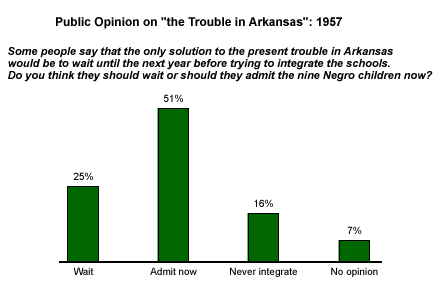A two-part series examining data from the Â鶹´«Ã½AV Brain on desegregation of public schools
Forty-five years ago, 15-year-old Elizabeth Eckford walked alone toward Little Rock (Ark.) Central High School. Each step took her closer to an education that she envisioned would better prepare her for college -- but also closer to a direct confrontation with hatred. Eckford, unlike any other students who had attended Central High, was black.
Eckford didn't even make it through the school doors that day. After navigating a hostile crowd and a gantlet of insults and threats, Eckford found her entrance blocked by Arkansas National Guard troops -- on the orders of Arkansas Gov. Orval Faubus. Despite a federal school desegregation order, none of the nine black students (known as the "Little Rock Nine") who volunteered to be the first to attend all-white Central High were allowed to go to school that morning in September 1957.
A few weeks later, the governor removed the guardsmen on court order and the black students secretly entered the school. When the crowd discovered the students were in the school, chaos ensued.
"The local police were not able to hold back the mob," recalls Eckford, now 61 and a probation officer in Little Rock. "By that time, the mob had grown to 1,000 people and they were about to go into the school. Police took us out for our own protection."
By that point, newspaper, television, and radio coverage of the desegregation attempts had blanketed the nation. Results from a Â鶹´«Ã½AV Poll conducted Sept. 19-24, 1957, revealed that 95% of Americans said they had either heard or read "about the trouble in Little Rock, Arkansas over school integration."
"One of the things that was significant about '57," Eckford says, "was that that was the first time that the public saw events in the context in which they happened. They didn't have to be reinterpreted by television reporters."
Of those Americans who had either heard or read of the trouble in Little Rock, 47% believed Arkansas' governor had done the wrong thing in placing the guardsmen around the school, 42% said he had done the right thing, and 11% had no opinion.
Results from that same September poll indicated that more Americans thought the nine black students should be admitted immediately to the high school, rather than wait a year as one proposed solution to the "present trouble in Arkansas." Fifty-one percent of Americans thought the students should be admitted "now," 25% thought they should "wait," 16% volunteered that they should "never integrate," and 7% offered no opinion.

Eckford believes the "admit now" percentage probably reflected the effect of the dramatic images of the conflict.
"By that time, there had been a violent mob, and both still and television pictures showed people being beaten," she says. "They beat not just the black reporters, they beat the entire Life magazine staff and anybody who had been identified as being supportive of desegregation."
The President Acts
On Sept. 24, 1957, President Dwight D. Eisenhower ordered roughly 1,000 troops and federalized the 10,000-man Arkansas National Guard to enforce the federal desegregation order in Little Rock. The black students were escorted under guard into the school on Sept. 25.
Â鶹´«Ã½AV Polls conducted in early and mid-October 1957 indicated that most Americans approved of Eisenhower's handling of the situation -- 58% approved, 31% disapproved, and 10% had no opinion.
Although a majority of Americans (64%) thought Eisenhower had done the right thing in calling out the troops to guard the school, there was an obvious difference between what Southerners and the rest of the country thought. In the South only, 36% said Eisenhower had done the right thing, while 53% said he had done the wrong thing. Outside the South, 74% said Eisenhower had done the right thing, and 16% said he did the wrong thing.
"Eisenhower was very, very reluctant to act," Eckford remembers. "He had 18 days over which he was trying to persuade the governor to withdraw the troops so that he wouldn't have to act." Â鶹´«Ã½AV asked Americans if they thought that Eisenhower should have sent the troops into Little Rock sooner than he did. Nineteen percent agreed with that point of view, 64% disagreed, and 17% were undecided.
Next week's installment examines Eckford's experience at Little Rock Central High School, and public opinion of events following that critical standoff in September 1957.